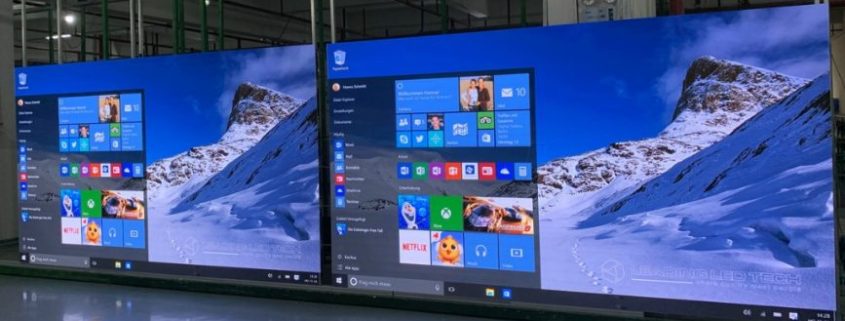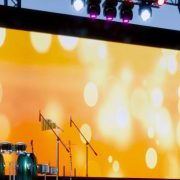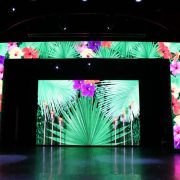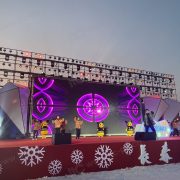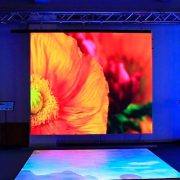Outdoor Events Shine with Small Stage LED Screen
The evolution of stage design has been significantly influenced by the advent of LED technology, with small stage LED screen becoming a pivotal element in modern performances. These compact yet powerful displays offer unparalleled vibrancy and flexibility, allowing for dynamic stage presentations that captivate audiences. The trend towards incorporating small stage LED screens is driven by their ability to enhance visual storytelling, making them an essential tool for event organizers and stage designers seeking to create memorable experiences.
What are the Small Stage LED Screen Prices
The introduction of LED screen technology has transformed the visual experience of small stages, making it possible for even intimate venues to deliver impactful, high-quality visuals. However, navigating the costs associated with small stage LED screens can be complex, with a variety of factors influencing price. This guide aims to demystify these factors and offer strategies for budgeting effectively, ensuring that even small venues can leverage this technology to create memorable experiences.
Factors Influencing the Cost of Small Stage LED Screens
- Pixel Pitch: The pixel pitch of an LED screen, which measures the distance between the centers of two adjacent pixels, significantly impacts its cost. Smaller pixel pitches mean higher resolution and better image quality but come at a higher price. For small stages, where viewers might be closer to the screen, a finer pixel pitch is often desirable.
- Screen Size: The dimensions of the LED screen directly affect its price. Even for small stages, the required screen size can vary based on the venue’s size and the desired impact of the visuals. Larger screens require more LEDs and supporting hardware, increasing the overall cost.
- Brightness and Contrast: High brightness levels are crucial for visibility in various lighting conditions, especially if the event is in a well-lit area or outdoors. Screens with higher brightness and contrast capabilities typically cost more due to the advanced technology required to achieve these specifications.
- Build Quality and Durability: The construction quality of an LED screen affects both its price and longevity. Outdoor screens or those used in touring productions need to withstand transportation and environmental factors, necessitating a higher build quality and, consequently, a higher price.
- Advanced Features: Additional features such as IP rating for water and dust resistance, flexible panels for creative configurations, and connectivity options can also influence the cost. While these features may enhance a production, they will also increase the investment needed.
- Installation and Maintenance: The complexity of installing and maintaining an LED screen can also affect its total cost. Easier installation and low maintenance designs might reduce long-term costs but could have a higher initial purchase price.
Tips for Budgeting and Navigating Price Variations in the Market
- Assess Your Needs: Clearly define what you need from a small stage LED screen in terms of size, resolution, and other specifications. This will help avoid overspending on unnecessary features.
- Research and Compare: Spend time researching different suppliers and the products they offer. Comparing prices and specifications can help you find the best value for your specific needs.
- Consider Refurbished or Used Screens: For smaller budgets, looking into refurbished or used LED screens can be a cost-effective solution. Ensure that the seller is reputable and that the equipment is in good condition.
- Explore Rental Options: If the LED screen is needed for a single event or on an occasional basis, renting might be more economical. This option also allows access to the latest technology without a significant investment.
- Plan for Total Cost of Ownership: Include not just the purchase price but also installation, maintenance, and any necessary training in your budget. Considering these costs upfront can prevent unexpected expenses later on.
- Negotiate with Suppliers: Don’t hesitate to negotiate pricing, especially if you are purchasing multiple items or planning a long-term partnership with the supplier. Discounts, extended warranties, or added services can often be negotiated.
- Seek Financing Options: Some suppliers offer financing plans that can spread the cost of the LED screen over time, making it more manageable for smaller venues or businesses.
- Monitor Sales and Discounts: Manufacturers and suppliers may offer sales, discounts, or incentive programs, especially during trade shows or industry events. Keeping an eye on these opportunities can lead to significant savings.
While the cost of incorporating a small stage LED screen into a venue or event can vary widely, understanding the factors that influence price and knowing how to navigate the market can make this powerful technology accessible. By carefully considering needs, doing thorough research, and exploring all options, it’s possible to find a small stage LED screen solution that meets both your visual requirements and budget constraints, thereby enhancing the stage presence and audience experience.
Advantages of Small Stage LED Screen for Outdoor Events
In the dynamic world of live events, the visual component plays a crucial role in creating an immersive and memorable experience for the audience. This is particularly true for outdoor events, where the vastness of the open air and the unpredictability of natural elements can pose unique challenges. Enter the small stage LED screen, a technological marvel that has revolutionized the way outdoor events are presented. Compact, versatile, and resilient, these screens offer a plethora of advantages that make them an indispensable asset for any outdoor event. From music festivals to corporate gatherings, small stage LED screens enhance the visual experience, ensuring that every performance is not just seen but truly felt by the audience.
Unmatched Versatility
One of the standout features of small stage LED screens is their incredible versatility. Their compact size does not limit their capability; instead, it opens up a world of creative possibilities for event organizers and stage designers. These screens can be easily integrated into various stage setups, from intimate acoustic performances to grand theatrical productions. They can serve as dynamic backdrops, displaying vibrant visuals that complement the live performance, or act as the main focal point, captivating the audience with high-definition imagery.
The modular nature of small stage LED screens allows for customization in size and shape, enabling designers to create unique configurations that fit the specific needs of each event. Whether it’s a curved screen that wraps around the stage for a 360-degree visual experience or a series of smaller screens strategically placed for maximum impact, the flexibility of these screens empowers creative minds to push the boundaries of traditional stage design.
Impactful Visuals in Any Light
Outdoor events are often at the mercy of natural lighting conditions, which can vary dramatically throughout the day. Small stage LED screens, with their high brightness and contrast ratios, cut through the brightest sunlight, ensuring that visuals remain clear and impactful, even in broad daylight. As the sun sets, these screens continue to shine, their vibrant colors and deep blacks creating a mesmerizing spectacle that keeps the audience engaged.
This ability to deliver consistent visual quality in any lighting condition is particularly valuable for events that transition from day to night. It ensures a seamless visual experience for the audience, with no need for adjustments or compromises in the content displayed.
Weather Resistance and Durability
Outdoor events require equipment that can withstand the elements, and small stage LED screens are built to do just that. High-quality screens are designed with weather resistance in mind, featuring robust enclosures that protect against rain, dust, and wind. This durability ensures that the show can go on, regardless of the weather conditions, giving event organizers peace of mind and reducing the risk of technical difficulties during the event.
Moreover, the longevity of LED technology means that these screens can be used repeatedly, providing a cost-effective solution for event organizers who require reliable equipment for a busy schedule of outdoor events. The durability of small stage LED screens not only makes them a practical choice but also an environmentally friendly one, as their long lifespan reduces the need for frequent replacements.
Enhanced Audience Engagement
The primary goal of any event is to engage the audience, and small stage LED screens excel in this regard. By bringing visuals closer to the audience, these screens create a more intimate and immersive experience, even in large outdoor settings. They can display a wide range of content, from live feeds of the performance that allow attendees to see every detail up close to interactive elements that encourage audience participation.
For events that feature multiple acts or speakers, small stage LED screens offer the flexibility to quickly change the visual theme to match each segment, maintaining the audience’s interest and ensuring a cohesive visual narrative throughout the event. This level of engagement is invaluable in creating memorable experiences that resonate with attendees long after the event has concluded.
The advantages of small stage LED screens for outdoor events are clear. Their versatility, ability to deliver impactful visuals in any lighting condition, weather resistance, and capacity to enhance audience engagement make them an essential tool for event organizers and stage designers. As technology continues to advance, the potential applications for these screens will only expand, further solidifying their role in the future of outdoor events. Whether it’s a local community gathering or a major music festival, small stage LED screens have the power to elevate the event, ensuring that every moment is not just seen but truly experienced by the audience.
Selecting the Best Small Stage LED Screen
In the quest to elevate the visual impact of performances on small stages, selecting the right LED screen is pivotal. A small stage LED screen not only enhances the audience’s experience but also serves as a dynamic backdrop that can adapt to various themes and settings. Given the vast array of options available in the market, identifying the key features essential for stage applications and knowing which products stand out for their performance and reliability can guide you in making an informed decision. This detailed exploration aims to demystify the process of choosing the best small stage LED screen, focusing on critical attributes and spotlighting top performers in the field.
Key Features to Look for When Choosing a Small Stage LED Screen
When selecting an LED screen for a small stage, certain features are critical to ensure it meets the unique demands of live performances. Understanding these features will help you choose a screen that not only fits your current needs but is also versatile enough to accommodate future requirements.
- High Resolution: For small stages, where the audience is relatively close to the screen, high resolution is crucial for clear, detailed images. A smaller pixel pitch (distance between pixels) is indicative of higher resolution, providing crisp visuals even at close viewing distances.
- Brightness and Contrast: Adequate brightness ensures that visuals are visible even in well-lit environments, while a high contrast ratio contributes to vibrant images with deep blacks and bright whites. This is particularly important for maintaining the quality of visuals in various lighting conditions typical of stage settings.
- Reliability and Durability: Given the frequent setups, breakdowns, and potential outdoor use, a small stage LED screen must be built to withstand the rigors of performance environments. Durability and reliability are non-negotiable features to prevent disruptions during events.
- Ease of Setup and Portability: For small venues or traveling shows, the ease with which an LED screen can be set up, dismantled, and transported is a key consideration. Lightweight, modular designs that require minimal technical expertise for assembly are highly desirable.
- Flexible Configuration: The ability to configure the screen in various shapes or configurations allows for creative freedom in stage design. This flexibility can be a significant advantage in adapting the screen to different performances or venue limitations.
- Energy Efficiency: Energy-efficient LED screens not only reduce operating costs but also support environmental sustainability. Efficient power consumption is especially important for smaller venues mindful of their energy usage.
Highlighting Top Products Known for Their Performance and Reliability in Small Stage Setups
While there are numerous products on the market, a few stand out for their exceptional performance and reliability in small stage applications. These products are renowned for their quality, versatility, and ability to enhance stage presentations:
- The UltraFine Pitch Series: Known for its incredibly small pixel pitch, the UltraFine Pitch series offers unparalleled image clarity and detail, making it an excellent choice for small stage environments where viewers are close to the screen. Its high brightness and contrast ratio ensure that visuals remain vivid under stage lighting conditions.
- The Modular Flex Series: This series stands out for its flexible configuration options. The Modular Flex screens can be curved, bent, and shaped to fit creative stage designs, offering unparalleled versatility for small stage setups. Its ease of assembly and disassembly makes it a favorite among traveling performances and venues with limited setup time.
- The EcoBright Lite Series: For venues prioritizing energy efficiency, the EcoBright Lite series offers an optimal solution without compromising on brightness or color accuracy. These screens are designed for low power consumption, making them ideal for small stages conscious of their environmental impact and operational costs.
- The RuggedPro Series: Designed with durability in mind, the RuggedPro series is built to withstand the demands of outdoor performances and touring conditions. Its robust construction ensures reliability through various weather conditions and the rigors of transport and frequent setup changes.
When choosing a small stage LED screen, it’s important to consider these key features and product options to ensure that your selection not only enhances the visual experience of your performances but also offers the durability, flexibility, and efficiency required for your specific stage setup. By focusing on high-resolution displays, brightness, contrast, ease of use, and energy efficiency, and by selecting a product known for its reliability, you can transform any small stage into a dynamic and visually captivating space.
LED Screen Rentals: A Cost-Effective Solution for Stages
In the dynamic world of event production, the quest for visually stunning and engaging stage setups is perpetual. Amidst this quest, the advent of LED technology, particularly small stage LED screens, has been a game-changer. However, the outright purchase of these cutting-edge displays can be a significant financial undertaking, especially for one-off events or smaller organizations. This is where the concept of LED screen rentals comes into play, offering a cost-effective and flexible solution that caters to a wide array of event types and scales. Delving into the realm of renting small stage LED screens unveils a plethora of benefits, from financial savings to adaptability, making it an increasingly popular choice among event organizers.
Financial Viability and Savings
The primary allure of opting for small stage LED screen rentals lies in their financial viability. Purchasing high-quality LED screens requires a substantial initial investment, a cost that can be prohibitive for many, especially when the frequency of use doesn’t justify the expense. Rentals, on the other hand, allow access to the latest technology without the hefty price tag, enabling event organizers to allocate their budgets more efficiently across other aspects of the event.
Moreover, the rental model absolves the lessee from long-term maintenance and upgrade costs. LED technology is continually evolving, with newer models offering enhanced features and improved performance. Rental agreements enable event organizers to leverage the latest advancements without the financial burden of upgrading owned equipment, ensuring that the stage visuals are always cutting-edge.
Flexibility and Customization
One of the standout benefits of renting small stage LED screens is the unparalleled flexibility it offers. Events come in all shapes and sizes, each with its unique requirements and challenges. The modular nature of LED screens allows for a high degree of customization, enabling organizers to tailor the screen size, configuration, and even the pixel pitch to suit the specific needs of each event.
This adaptability extends to the content displayed on the screens. From high-resolution live feeds and dynamic backdrops to interactive social media walls, the possibilities are virtually limitless. Rental companies often provide comprehensive support, including content management solutions and technical assistance, ensuring that the visuals are not only stunning but also seamlessly integrated into the event’s overall theme and flow.
Ease of Use and Technical Support
Navigating the technical complexities of setting up and operating small stage LED screens can be daunting, particularly for those with limited experience. Rental companies typically offer end-to-end services that include delivery, setup, calibration, and dismantling, significantly reducing the logistical burden on the event organizers. This turnkey solution ensures that the screens are optimally configured for the best possible visual experience, with minimal effort required from the event team.
In addition to the setup, rental agreements often encompass technical support throughout the event’s duration. This on-site or on-call assistance is invaluable, providing immediate resolution to any technical issues that may arise, ensuring uninterrupted visual engagement for the audience.
Catering to Various Event Types and Scales
The versatility of small stage LED screens, coupled with the flexibility of rental options, makes them an ideal choice for a wide range of events. From intimate corporate gatherings and private celebrations to large-scale concerts and festivals, LED screens can enhance the visual appeal and audience engagement of any event. The ability to customize the screen size and configuration means that the visual setup can be scaled up or down to match the event’s scope, ensuring that the impact is always proportionate and appropriate.
For recurring events or those with varying themes, the rental model allows organizers to alter the visual setup for each occasion, keeping the audience experience fresh and engaging. This adaptability is particularly beneficial for venues that host a diverse array of events, providing them with the flexibility to meet the distinct visual requirements of each client.
The rental of small stage LED screens presents a compelling solution for event organizers seeking to elevate their stage presentations without the financial and logistical burdens associated with ownership. The cost-effectiveness, flexibility, ease of use, and comprehensive support offered by rental options make them an attractive choice for events of all types and scales. As the demand for immersive and engaging visual experiences continues to grow, the role of LED screen rentals in the event industry is set to expand, bringing the transformative power of LED technology within reach of a broader audience.
LED Stage Screens for Sale: Making the Right Investment
In the ever-evolving landscape of live performances and events, the visual component plays a pivotal role in captivating the audience and elevating the overall experience. Within this visual domain, LED technology, particularly small stage LED screens, has emerged as a game-changer, offering unparalleled brightness, clarity, and versatility. The decision to invest in a small stage LED screen is significant, involving careful consideration of various factors to ensure that the investment aligns with the long-term goals and needs of the venue or event management team. This comprehensive guide delves into the nuances of purchasing small stage LED screens, highlighting the long-term benefits and weighing the pros and cons against the option of renting.
Understanding the Value of Ownership
Owning a small stage LED screen comes with a host of advantages, chief among them being the complete control over the asset. This control extends to every aspect of usage, from the content displayed to the frequency and manner of deployment. For venues that host regular events or event management companies with a busy schedule, the convenience and readiness of having an in-house LED screen can be invaluable. It eliminates the need for repeated rental arrangements, ensuring that high-quality visual support is always at hand.
Moreover, ownership of a small stage LED screen opens up opportunities for customization and integration that might not be possible with rentals. The screen can be tailored to fit the specific architectural and aesthetic requirements of the stage or venue, becoming an integral part of the infrastructure rather than an add-on.
Financial Considerations: CapEx vs. OpEx
The decision to purchase an LED screen is primarily a capital expenditure (CapEx), requiring a significant upfront investment. This contrasts with the operational expenditure (OpEx) associated with renting, which spreads the cost over time. While the initial outlay for purchasing an LED screen can be substantial, it’s important to consider the total cost of ownership, which includes maintenance, repairs, and potential upgrades over the screen’s lifespan.
For organizations with the financial stability and foresight to invest in long-term assets, purchasing a small stage LED screen can be more cost-effective in the long run. The absence of rental fees, coupled with the potential for revenue generation through advertising or leasing the screen for external events, can offset the initial cost and contribute to a positive return on investment (ROI).
Long-Term Benefits of Ownership
Owning a small stage LED screen offers several long-term benefits that extend beyond financial considerations. These include:
- Brand Consistency: Having a dedicated LED screen allows for consistent branding and messaging across all events, reinforcing the venue or organization’s identity.
- Technological Familiarity: Regular use of the same equipment fosters a deep understanding of its capabilities and nuances, enabling the technical team to maximize its potential and troubleshoot issues more effectively.
- Dependability: Ownership eliminates the uncertainties associated with rentals, such as availability issues or variations in screen quality, ensuring that high standards are maintained for every event.
- Revenue Generation: Beyond its primary function, the LED screen can serve as a revenue source through advertising, partnerships, or by renting it out for external events.
Considerations for Buying vs. Renting
While the benefits of ownership are compelling, it’s crucial to weigh them against the specific needs and circumstances of your organization. Consider the following factors:
- Frequency of Use: Evaluate how often the screen will be used. If events are infrequent or seasonal, renting may be more economical.
- Technological Advancements: LED technology is rapidly evolving. Consider whether the investment aligns with your organization’s ability to adapt to or incorporate future technological advancements.
- Storage and Maintenance: Ownership entails responsibilities for storage, maintenance, and repairs. Ensure that you have the necessary infrastructure and technical expertise to manage these aspects.
- Financial Flexibility: Assess your organization’s financial health and flexibility. While purchasing provides long-term value, it requires a significant upfront investment that may impact cash flow.
Making the Right Investment
Investing in a small stage LED screen is a strategic decision that can significantly enhance the quality and impact of events. To make an informed investment:
- Research Thoroughly: Explore various models, manufacturers, and technologies to find a screen that matches your technical requirements and budget.
- Consult Experts: Engage with industry experts, technicians, and other users to gain insights into the performance and reliability of different screens.
- Consider Future Needs: Anticipate future events and potential changes in your venue or event types to ensure the screen’s versatility and adaptability.
- Evaluate Total Cost of Ownership: Look beyond the purchase price to consider maintenance, repair costs, and potential revenue streams.
The decision to purchase a small stage LED screen represents a significant investment in the future of your events. It offers the promise of enhanced visual experiences, brand consistency, and potential revenue generation. However, it requires careful consideration of financial, technological, and operational factors. By thoroughly evaluating your organization’s needs and the long-term benefits of ownership, you can make an informed decision that aligns with your strategic goals and ensures the lasting impact of your events.
Innovative LED Screen Stage Designs with Small Stage LED Screen Integration
In the dynamic world of stage design, the integration of small stage LED screens has opened up a new realm of creative possibilities, allowing designers to weave visual storytelling into the fabric of their presentations in more intimate settings. The versatility and vibrancy of LED technology have proven to be a game-changer, especially in smaller venues where every inch of space must be maximized for impact. This exploration delves into the innovative ways small LED screens can be creatively incorporated into stage designs, illustrated with case studies and examples that have set new benchmarks in the industry.
Creative Integration of Small Stage LED Screens in Stage Designs
Small stage LED screens offer a unique blend of flexibility and functionality, making them an ideal choice for adding depth and dimension to stage designs. Here’s how they can be creatively integrated:
- Dynamic Backdrops: Instead of static backdrops, small LED screens can display changing scenery, moving graphics, and interactive elements that evolve with the performance, creating a dynamic environment that engages audiences more deeply.
- Immersive Environments: By strategically placing small LED screens around the stage or even within the set pieces, designers can create immersive, 360-degree environments that envelop the audience in the narrative, making them feel like part of the action.
- Augmented Storytelling: Small LED screens can be used to augment storytelling, displaying key narrative elements, visual effects, or even live social media feeds related to the performance, thereby enhancing the narrative and engaging the audience in real-time.
- Interactive Performances: Incorporating interactivity, small LED screens can react to the performers’ actions or audience inputs, creating a unique, interactive experience where the visual elements respond and change based on live interactions.
Case Studies and Examples of Effective Small LED Screen Implementations
The following examples highlight how small stage LED screens have been effectively integrated into stage designs, pushing the boundaries of creativity and audience engagement:
- The “Living” Set of a Theatrical Production: In a groundbreaking theatrical production, small LED screens were embedded within set pieces to create a “living” set that changed and reacted to the storyline. Trees displayed on screens grew or lost their leaves as seasons changed in the narrative, and windows showed changing views that reflected the time of day and mood, providing a dynamic backdrop that supported the storytelling beautifully.
- Concert Visuals for an Acoustic Set: A well-known artist used small LED screens as part of an intimate acoustic concert series. Positioned around the stage, these screens displayed abstract visuals that responded to the music’s tempo and mood, creating an intimate atmosphere that connected the audience with the music on a deeper level.
- Interactive Dance Performance: In an innovative dance performance, small stage LED screens were used on the floor and backdrop, displaying visuals that interacted with the dancers’ movements. Sensors tracked the dancers, and the visuals on the screens responded in real-time, creating a captivating, interactive performance piece that blurred the lines between technology and art.
- Pop-Up Art Installation: A pop-up art installation utilized small LED screens to create an engaging, interactive exhibit. Visitors could manipulate the visuals on the screens through their movements and inputs, allowing them to become part of the art. This not only showcased the versatility of small LED screens but also demonstrated how they could be used to create interactive, immersive experiences beyond traditional stage settings.
- Educational Workshops and Seminars: In educational settings, small LED screens have transformed the stage into a dynamic learning environment. For workshops and seminars, these screens provided interactive presentations, real-time data visualization, and engaging backgrounds that made learning more interactive and visually stimulating.
These case studies underscore the transformative potential of small stage LED screens in enhancing stage designs across various applications. By integrating these screens creatively, designers and performers can craft unforgettable experiences that resonate with audiences, making every performance not just a presentation but a journey into a visually rich narrative. As technology evolves, the possibilities for small stage LED screen integration continue to expand, promising even more innovative and immersive designs in the future.
FAQs about Small Stage LED Screen
The smallest pixel pitch in LED screens refers to the distance between the centers of two adjacent pixels, which directly affects the resolution and clarity of the display. As of my last update in April 2023, the industry has seen pixel pitches go down to around 0.6mm to 0.9mm for ultra-high-resolution LED screens. These are typically used in settings where viewers will be very close to the screen and require a high level of detail, such as control rooms, broadcast studios, and luxury retail environments. Technology continues to evolve, and manufacturers are constantly striving to reduce the pixel pitch even further, enhancing the resolution and image quality of LED displays.
Stage screens, particularly those used for concerts, events, and theatrical performances, can vary widely in size depending on the venue, audience size, and the specific requirements of the event. Generally, stage LED screens can range from as small as 10 feet by 5.6 feet (approximately 3 meters by 1.7 meters) for smaller venues or as elements of a larger backdrop, to over 100 feet wide for large-scale outdoor festivals and major concert events. The flexibility of LED technology allows for customized sizes to fit the creative and technical demands of any production.
In LED screen theaters, where traditional projection systems are replaced with LED technology to enhance picture quality and viewer experience, the screen sizes can also vary. However, they typically range from around 30 feet (9 meters) wide in smaller cinema halls to over 70 feet (21 meters) wide in larger venues or for premium large-format (PLF) screens. The introduction of LED screens in theaters aims to provide brighter, more vibrant images with higher contrast levels compared to standard projection systems.
The primary difference between LED (Light Emitting Diode) and LCD (Liquid Crystal Display) screens lies in their backlighting technology and how they produce images:
LCD Screens: These screens use liquid crystal displays to control the passage of light. They are typically backlit by fluorescent lamps (CCFL LCD) or, more commonly now, by LED lights (LED-backlit LCD). Despite the LED backlighting, the term “LCD” is still used because the core technology of using liquid crystals remains the same. LCD screens are widely used in televisions, monitors, and mobile device displays.
LED Screens: When referring to “LED screens” in the context of large displays or signage, it generally means direct LED displays, where each pixel is made up of small LEDs. This technology does not involve liquid crystals; the LEDs themselves emit the light and color seen by the viewer. LED screens offer higher brightness, contrast ratios, and more vibrant colors compared to LCD screens. They are often used for outdoor screens, stage productions, and large-format advertising due to their visibility in daylight and flexibility in size.
In essence, the key difference lies in the display technology and the method of light production—direct light emission from LEDs in LED screens versus the manipulation of backlight through liquid crystals in LCDs.

